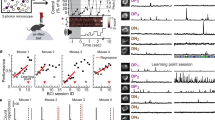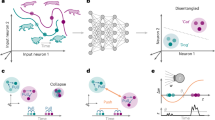Abstract
Training was found to improve the performance of humans on a variety of visual perceptual tasks1,2. However, the ability to detect small changes in the contrast of simple visual stimuli could not be improved by repetition3. Here we show that the performance of this basic task could be modified after the discrimination of the stimulus contrast was practised in the presence of similar laterally placed stimuli, suggesting a change in the local neuronal circuit involved in the task. On the basis of a combination of hebbian and anti-hebbian synaptic learning rules compatible with our results, we propose a mechanism of plasticity in the visual cortex that is enabled by a change in the context.
This is a preview of subscription content, access via your institution
Access options
Subscribe to this journal
Receive 51 print issues and online access
$199.00 per year
only $3.90 per issue
Buy this article
- Purchase on Springer Link
- Instant access to full article PDF
Prices may be subject to local taxes which are calculated during checkout




Similar content being viewed by others
References
Sagi, D. & Tanne, D. Perceptual learning: learning to see. Curr. Opin. Neurobiol. 4, 155–159 (1994).
Karni, A. The acquisition of perceptual and motor skills: a memory system in the adult human cortex. Brain Res. Cogn. Brain Res. 5, 39–48 (1996).
Dorais, A. & Sagi, D. Contrast masking effects change with practice. Vision Res. 37, 1725–1733 (1997).
Karni, A. & Sagi, D. Where practice makes perfect in texture discrimination-evidence from primary visual cortex plasticity. Proc. Natl Acad. Sci. USA 88, 4966–4970 (1991).
Polat, U. & Sagi, D. Spatial interactions in human vision: from near to far via experience-dependent cascades of connections. Proc. Natl Acad. Sci. USA 91, 1206–1209 (1994).
Fahle, M., Edelman, S. & Poggio, T. Fast perceptual learning in hyperacuity. Vision Res. 35, 3003–3013 (1995).
Schoups, A., Vogels, R. & Orban, N. Q. G. Practicing orientation identification improves orientation coding in V1 neurons. Nature 412, 549–553 (2001).
Crist, R. E., Li, W. & Gilbert, C. D. Learning to see: experience and attention in primary visual cortex. Nature Neurosci. 4, 519–425 (2001).
Zenger, B. & Sagi, D. in Textbook on ‘Perceptual Learning’ (eds Fahle, M. & Poggio, T.) Ch. 10, 177–196 (MIT Press, Boston, 2002).
Boynton, G. M., Demb, J. B., Glover, G. H. & Heeger, D. J. Neuronal basis of contrast discrimination. Vision Res. 39, 257–269 (1999).
Karni, A. & Sagi, D. The time course of learning a visual skill. Nature 365, 250–252 (1993).
Adini, Y., Sagi, D. & Tsodyks, M. Excitatory-inhibitory network in the visual cortex: psychophysical evidence. Proc. Natl Acad. Sci. USA 94, 10426–10431 (1997).
Legge, G. E. A power law for contrast discrimination. Vision Res. 21, 457–467 (1981).
Marcelja, S. Mathematical description of the responses of simple cortical cells. J. Opt. Soc. Am. 70, 1297–1300 (1980).
Pollen, D. A. & Romer, S. F. Visual cortical neurons as localized spatial frequency filters. IRRR Trans. Syst. Man Cybern. SMC-13, 907–916 (1983).
Adini, Y. & Sagi, D. Recurrent networks in human visual cortex: psychophysical evidence. J. Opt. Soc. Am. A 18, 2228–2236 (2001).
Zenger-Landolt, B. & Koch, C. Flanker effects in peripheral contrast discrimination—psychophysics and modeling. Vision Res. 41, 3663–3675 (2001).
Wilson, H. R. & Humanski, R. Spatial frequency adaptation and contrast gain control. Vision Res. 33, 1133–1149 (1993).
Foley, J. M. Human luminance pattern-vision mechanisms: Masking experiments require a new model. J. Opt. Soc. Am. A 11, 1710–1719 (1994).
Senn, W., Markram, H. & Tsodyks, M. An algorithm for modifying neurotransmitter release probability based on pre- and postsynaptic spike timing. Neur. Computat. 13, 35–67 (2001).
Markram, H., Lubke, J., Frotscher, M. & Sakmann, B. Regulation of synaptic efficacy by coincidence of postsynaptic APs and EPSPs. Science 275, 213–215 (1997).
Bell, C. C., Han, V. Z., Sugawara, Y. & Grant, K. Synaptic plasticity in a cerebellum-like structure depends on temporal order. Nature 387, 278–281 (1997).
Bi, G. Q. & Poo, M. M. Synaptic modifications in cultured hippocampal neurons: dependence on spike timing, synaptic strength, and postsynaptic cell type. J. Neurosci. 18, 10464–10472 (1998).
Abbott, L. F. & Nelson, S. B. Synaptic plasticity: taming the beast. Nature Neurosci. 3, 1178–1183 (2000).
Somers, D. C. et al. A local circuit approach to understanding integration of long-range inputs in primary visual cortex. Cereb. Cortex 8, 204–217 (1998).
Walker, G. A., Ohzawa, I. & Freeman, R. D. Suppression outside the classical cortical receptive field. Vis. Neurosci. 17, 369–379 (2000).
Gabor, D. Theory of communication. J. Inst. Elect. Eng. (Lond.) 93, 429–457 (1946).
Wilson, H. R. & Cowan, J. D. A mathematical theory of the functional dynamics of cortical and thalamic nervous tissue. Kybernetic 13, 55–80 (1973).
Tsodyks, M. V., Skaggs, W. E., Sejnowski, T. J. & McNaughton, B. L. Paradoxical effects of external modulation of inhibitory interneurons. J. Neurosci. 17, 4382–4388 (1997).
Albrecht, D. G. & Hamilton, B. Striate cortex of monkey and cat: contrast response function. J. Neurophysiol. 48, 217–237 (1982).
Naka, K. I. & Rushton, W. A. H. S-potentials from luminosity units in the retina of fish (cyprinidae). J. Physiol. Lond. 185, 587–599 (1966).
Acknowledgements
We thank E. Ahissar, Y. Dudai and H. Markram for helpful comments on the manuscript. This research was supported by the Israeli Academy of Sciences, US-Israel Binational Foundation, the Office of Naval Research and the National Science Foundation.
Author information
Authors and Affiliations
Corresponding author
Ethics declarations
Competing interests
The authors declare no competing financial interests.
Rights and permissions
About this article
Cite this article
Adini, Y., Sagi, D. & Tsodyks, M. Context-enabled learning in the human visual system. Nature 415, 790–793 (2002). https://doi.org/10.1038/415790a
Received:
Accepted:
Issue Date:
DOI: https://doi.org/10.1038/415790a
This article is cited by
-
Effects of task-specific strategy on attentional control game training: preliminary data from healthy adults
Current Psychology (2024)
-
Awake suppression after brief exposure to a familiar stimulus
Communications Biology (2021)
-
Disentangling locus of perceptual learning in the visual hierarchy of motion processing
Scientific Reports (2019)
-
Tactile perceptual learning: learning curves and transfer to the contralateral finger
Experimental Brain Research (2013)
-
Self-motion perception training: thresholds improve in the light but not in the dark
Experimental Brain Research (2013)
Comments
By submitting a comment you agree to abide by our Terms and Community Guidelines. If you find something abusive or that does not comply with our terms or guidelines please flag it as inappropriate.



